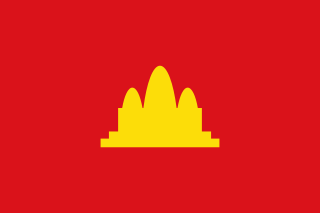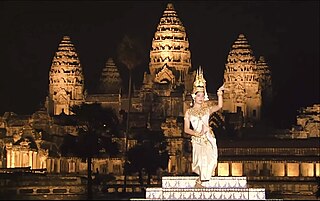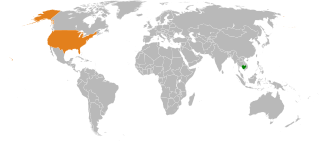The history of Cambodia, a country in mainland Southeast Asia, can be traced back to Indian civilization. Detailed records of a political structure on the territory of what is now Cambodia first appear in Chinese annals in reference to Funan, a polity that encompassed the southernmost part of the Indochinese peninsula during the 1st to 6th centuries. Centered at the lower Mekong, Funan is noted as the oldest regional Hindu culture, which suggests prolonged socio-economic interaction with maritime trading partners of the Indosphere in the west. By the 6th century a civilization, called Chenla or Zhenla in Chinese annals, firmly replaced Funan, as it controlled larger, more undulating areas of Indochina and maintained more than a singular centre of power.

The Khmer Rouge is the name that was popularly given to members of the Communist Party of Kampuchea (CPK) and by extension to the regime through which the CPK ruled Cambodia between 1975 and 1979. The name was coined in the 1960s by then Chief of State Norodom Sihanouk to describe his country's heterogeneous, communist-led dissidents, with whom he allied after the 1970 Cambodian coup d'état.

Marshal Lon Nol was a Cambodian military officer and politician who served as Prime Minister of Cambodia twice, as well as serving repeatedly as defence minister and provincial governor. As a nationalist and conservative, he led the military coup of 1970 against Prince Norodom Sihanouk, abolished the monarchy, and established the short-lived Khmer Republic. Constitutionally a semi-presidential republic, Cambodia was de facto governed under a military dictatorship. He was the commander-in-chief of the Khmer National Armed Forces during the Cambodian Civil War. On April 1, 1975, 16 days before the Khmer Rouge captured Phnom Penh, Lon Nol fled to the United States, first to Hawaii and then to California, where he remained until his death in 1985.

Cambodia, officially the Kingdom of Cambodia, is a country in Mainland Southeast Asia. It borders Thailand to the northwest, Laos to the north, Vietnam to the east, and has a coastline along the Gulf of Thailand on the southwest. It spans an area of 181,035 square kilometres, and has a population of about 17 million. Its capital and most populous city is Phnom Penh.

The post-Angkor period of Cambodia, also called the Middle period, refers to the historical era from the early 15th century to 1863, the beginning of the French protectorate of Cambodia. As reliable sources are very rare, a defensible and conclusive explanation that relates to concrete events that manifest the decline of the Khmer Empire, recognised unanimously by the scientific community, has so far not been produced. However, most modern historians have approached a consensus in which several distinct and gradual changes of religious, dynastic, administrative and military nature, environmental problems and ecological imbalance coincided with shifts of power in Indochina and must all be taken into account to make an interpretation. In recent years scholars' focus has shifted increasingly towards human–environment interactions and the ecological consequences, including natural disasters, such as flooding and droughts.

Pursat is a province of Cambodia. It is in the western part of the country and borders clockwise from the north: Battambang province, the Tonlé Sap, Kampong Chhnang province, Kampong Speu province, Koh Kong province, and East Thailand. It lies between the Tonle Sap and the northern end of the Cardamom Mountains. The Pursat River bisects the province, running from the Cardamoms in the west to the Tonle Sap in the east.

Throughout Cambodia's long history, religion has been a major source of cultural inspiration. Over nearly two millennia, Cambodians have developed a unique Cambodian culture and belief system from the syncreticism of indigenous animistic beliefs and the Indian religions of Buddhism and Hinduism. Cambodia's achievements in art, architectures, music, and dance from the 9th and 14th century have had a great influence on many neighboring kingdoms, namely Thailand and Laos. The effect of Khmer culture can still be seen today in those countries, as they share many close characteristics with current-day Cambodia. The Tai borrowed from the Khmer many elements of Indianized Khmer culture, including royal ceremonies, customs followed at the court, and especially the Indian epic Ramayana, which influenced not only literature but also classical dance. Even in modern Thai culture the legacy of ancient Khmer culture is still evident.

The Khmer people are an Austroasiatic ethnic group native to Cambodia. They comprise over 95% of Cambodia's population of 17 million. They speak the Khmer language, which is part of the larger Austroasiatic language family alongside Mon and Vietnamese.
Year Zero is an idea put into practice by Pol Pot in Democratic Kampuchea that all culture and traditions within a society must be completely destroyed or discarded and that a new revolutionary culture must replace it starting from scratch. In this sense, all of the history of a nation or a people before Year Zero would be largely deemed irrelevant, because it would ideally be purged and replaced from the ground up.

The equestrian events at the 1956 Summer Olympics were held in Stockholm due to the Australian quarantine regulations and included dressage, eventing, and show jumping. All three disciplines had both individual and team competitions. The competitions were held from 11 to 17 June 1956 at Stockholm Olympic Stadium. There were 158 entries from 29 National Olympic Committees: Argentina, Australia, Austria, Belgium, Brazil, Bulgaria, Cambodia, Canada, Denmark, Egypt, Finland, France, Germany, Great Britain, Hungary, Ireland, Italy, Japan, Netherlands, Norway, Portugal, Romania, Soviet Union, Spain, Sweden, Switzerland, Turkey, USA and Venezuela. This would be the first appearance for Australia, Cambodia and Venezuela in equestrian events.
The 1970 Cambodian coup d'état was the removal of the Cambodian Chief of State, Prince Norodom Sihanouk, after a vote in the National Assembly on 18 March 1970. Emergency powers were subsequently invoked by the Prime Minister Lon Nol, who became effective head of state, and led ultimately to the removal of Queen Sisowath Kossamak and the proclamation of the Khmer Republic later that year. It is generally seen as a turning point in the Cambodian Civil War. No longer a monarchy, Cambodia was semi-officially called "État du Cambodge" in the intervening six months after the coup, until the republic was proclaimed.

Buddhism in Cambodia or Khmer Buddhism has existed since at least the 5th century. In its earliest form it was a type of Mahāyāna Buddhism. Today, the predominant form of Buddhism in Cambodia is Theravada Buddhism. It is enshrined in the Cambodian constitution as the official religion of the country. Theravada Buddhism has been the Cambodian state religion since the 13th century. As of 2019 it was estimated that 97.1 percent of the population are Buddhists.

Operation Menu was a covert United States Strategic Air Command (SAC) tactical bombing campaign conducted in eastern Cambodia from 18 March 1969 to 26 May 1970 as part of both the Vietnam War and the Cambodian Civil War. The targets of these attacks were sanctuaries and base areas of the People's Army of Vietnam and forces of the Viet Cong (VC), which used them for resupply, training, and resting between campaigns across the border in the Republic of Vietnam. The impact of the bombing campaign on the Khmer Rouge guerrillas, the PAVN, and Cambodian civilians in the bombed areas is disputed by historians.

The Cambodian campaign was a series of military operations conducted in eastern Cambodia in mid-1970 by South Vietnam and the United States as an expansion of the Vietnam War and the Cambodian Civil War. Thirteen operations were conducted by the Army of the Republic of Vietnam (ARVN) between April 29 and July 22 and by U.S. forces between May 1 and June 30, 1970.

Bilateral relations between the United States and Cambodia, while strained throughout the Cold War, have strengthened considerably in modern times. The U.S. supports efforts in Cambodia to combat terrorism, build democratic institutions, promote human rights, foster economic development, eliminate corruption.
The CIA conducted secret operations in Cambodia and Laos for eight years as part of the conflict against Communist North Vietnam.

Ang Mey was a monarch of Cambodia. Her official title was Samdech Preah Mahā Rājinī Ang Mey. She was one of the few female rulers in Cambodia's history, and the first one since Queen Tey. Installed on the Cambodian throne by the Vietnamese, her reign was dominated by the Siamese-Vietnamese War (1841–1845).

The Cambodian genocide was the systematic persecution and killing of Cambodian citizens by the Khmer Rouge under the leadership of Prime Minister of Democratic Kampuchea, Pol Pot. It resulted in the deaths of 1.5 to 2 million people from 1975 to 1979, nearly 25% of Cambodia's population in 1975.
Traditional Cambodian medicine comprise several traditional medicine systems in Cambodia.
Ramathipadi I, also known as Ponhea Chan, Cau Bana Cand, Botum Reachea I, Nac Cham, or Sultan Ibrahim, reigning from 1642 to 1658, was the first and only Cambodian king to convert to Islam. Ramathipadi I was the third son of Chey Chettha II.














